Where Has the ‘Magic’ Gone? Disney’s Response to Digitization

MyMagic+, Disney’s $1 billion answer to digitization, has created a more interactive, customized, and convenient experience for guests. And it’s just getting started.
We all have our favorite Disney memory. Whether it was meeting Mickey Mouse for the first time, screaming as we dropped 13-stories on the Tower of Terror, or gazing at the evening firework display – the nostalgia and desire to relive the experience are what have kept customers coming back for the past 60 years. Now, as Disney faces generational change and digitization trends, one thing is certain: Disney must reinvent its guest experience through interactive technology to remain the “Happiest Place on Earth”.
Situational context
Starting in the mid-2000s, performance at Disney’s theme parks declined. Guests complained of long lines, high prices, and lack of innovation; in fact, over 50% of first-time visitors at Disney World indicated they would not return.[1] Simultaneously, digitization trends in form of social media and smart phones posed a significant threat to the relevance of parks going forward.[2] Disney needed to respond.
Disney’s response: MyMagic+
Challenged to improve its guest experience, Disney developed and introduced a comprehensive $1 billion platform known as MyMagic+ in 2014. The platform, which includes a website and mobile application (i.e., My Disney Experience) and wristband (i.e., MagicBand), collectively allows visitors to customize their experience at a Disney park. Embedded with a RFID chip, the MagicBand interfaces with the guest’s My Disney Experience account, and can be read at various RFID sensors (i.e., encircled with Mickey Mouse symbol) across the park, Disney hotels, restaurants, and stores.[3]
Functionality of MyMagic+
The following describes core benefits that MyMagic+ provides to consumers:
- Convenience: Guests no longer need to carry around cash/credit cards or wait in lines to buy tickets. By touching their MagicBand against designated RFID sensors, guests can avoid lines on rides and admission and replace the clutter: tickets, fast passes, and hotel room keys.
- Interactive Experiences: MyMagic+’s interactive potential is best demonstrated at Epcot’s Test Track, where guests customize their own car (color, shape, engine, aerodynamics, etc.) while waiting in line. During the ride, MagicBand integrates the guest’s personal vehicle into the ride, allowing the guest to see its performance capabilities in real-time. In addition to the rave reviews, studies show that guest perceived wait time has been reduced by over 60%.[4]
- Customization: Visitors can book three FastPass+ tickets in advance of their visit, resulting not only in reduced waiting times, but a greater ability to plan and customize their itinerary.[5]
- Personalization: By using the data provided by MyMagic+, Disney enables animatronics to interact with specific guests and individually recognize guests celebrating birthdays. At Be Our Guest restaurant, for example, sensors permit staff to greet customers by name and understand preferences. Additionally, guests who pre-ordered food online, sit down and have their meal arrive automatically because of RFID sensors.[6]
Operational benefits to Disney
Not only is MyMagic+ helping to deliver on Disney’s customer promise, but it is also provides significant operational benefits to Disney, resulting in greater efficiency and profitability:
- Increased capacity: At the Magic Kingdom alone, the implementation of MyMagic+ has allowed an additional 5,000 people into the park per day, roughly a 10% increase in daily capacity. Specifically, the platform enables Disney to shift crowds from long lines to shorter lines elsewhere in the park.[7]
- Data opportunities: Disney collects data from guests that enables the company to design ride enhancements, better forecast demand, and target customers based on preferences.[8]
- Revenue enhancements: The PhotoPass service, for example, has extended revenue generation beyond the park. By linking to MagicBands, photos are automatically updated to the My Disney Experience website, enabling guests to purchase anytime.[9]
Where should Disney go from here?
While Disney has invested over $1 billion and is off to a strong start, the work is not yet done. In order to ensure that Disney maintains its magic, Disney must continue to improve MyMagic+ functionality to enhance its interactive experience. As such, the following are some recommendations Disney should consider:
- More interactive rides – Only 2% of rides at Disney World are truly interactive with MagicBand.[10] This is a missed opportunity. Test Track, for example, has been received well; so why not expand to other rides, creating a differentiated and memorable experience for future generations?
- Use more data – Through MyMagic+ Disney is collecting valuable data on its guests that is currently underutilized. In addition to its current efforts, Disney can present customized marketing opportunities such as cold drink coupons after someone waited in a long line; this is no longer a one size fits all experience.
- Communicate in real-time – Disney should communicate with guests via smartphone app to better manage variability. This can better distribute demand, improve the park’s capacity, decrease wait times, and increase satisfaction.
Disney is on to something with its MyMagic+ platform, but it needs to go all-in now, ensuring that it satisfies its changing customer base, beats its competition, and preserves its distinction as the “Happiest Place on Earth.”
References:
[1] Carr, Austin (April 15, 2015). “The Messy Business of Reinventing Happiness”. Fast Company. Retrieved 15 November, 2016. <https://www.fastcompany.com/3044283/the-messy-business-of-reinventing-happiness>.
[2] Kuang, Cliff (March 10, 2015). “Disney’s $1 Billion Bet on a Magical Wristband”. Wired. Retrieved 27 August 2015. < https://www.wired.com/2015/03/disney-magicband>.
[3] CapGemini Consulting, N. “Disney: Making Magic Through Digital Innovation.” (2014): n. pag. Web. 14 Nov. 2016. <https://www.capgemini-consulting.com/resource-file-access/resource/pdf/disney_0.pdf>.
[4] Barnes, Brooks. “At Disney Parks, a Bracelet Meant to Build Loyalty (and Sales).” The New York Times. The New York Times, 06 Jan. 2013. Web. 18 Nov. 2016. <http://www.nytimes.com/2013/01/07/business/media/at-disney-parks-a-bracelet-meant-to-build-loyalty-and-sales.html>.
[5] @thedisneyblog. “FastPass+ and MyMagic+ Takeover Disney World – Part 3: The Marketing Push Begins | The Disney Blog.” The Disney Blog. N.p., 03 Apr. 2014. Web. 18 Nov. 2016. <http://thedisneyblog.com/2014/01/21/fastpass-and-mymagic-takeover-disney-world-part-3-the-marketing-push-begins/>.
[6] Disney. “Disney’s MyMagic+ Honored with ‘Innovation by Design’ Award.” Disney Parks Blog. N.p., n.d. Web. 18 Nov. 2016. <https://disneyparks.disney.go.com/blog/2014/10/disneys-mymagic-honored-with-innovation-by-design-award/>.
[7] Santo Domingo, Joel (July 31, 2015). “Hands On: Disney MagicBands, MyMagic+ Web Service”. PC Magazine, http://www.pcmag.com/article2/0,2817,2483861,00.asp
[8] Understanding Disney’s MyMagic+, and How to Use Fastpass+ to Your Advantage at Walt Disney World.” Theme Park Insider. N.p., n.d. Web. 18 Nov. 2016. <http://www.themeparkinsider.com/flume/201405/4009/>.
[9] Pedicini, Sandra (November 3, 2014). “Disney adds new photo features to MyMagic+”. Orlando Sentinel. Retrieved 17 November 2016.
[10] Carr, Austin (April 15, 2015). “The Messy Business of Reinventing Happiness”. Fast Company. Retrieved 15 November, 2016. <https://www.fastcompany.com/3044283/the-messy-business-of-reinventing-happiness>.


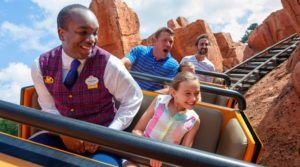
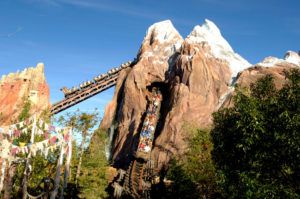

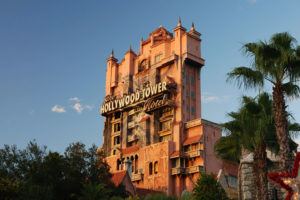

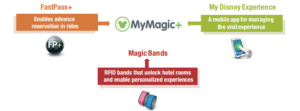
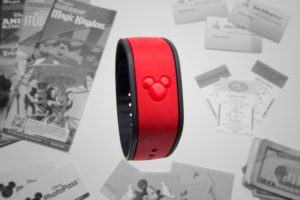

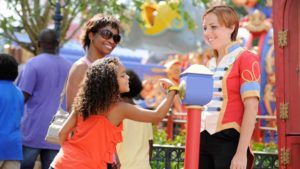
Thanks for sharing this – looks like the right move from Disney, and so much more chances to actually improve consumer experience. There is of course a question raised regarding privacy of the data, which some consumers might not be willing to give away to the company (at the time of launch 19% of respondents felt uncomfortable with this idea – http://www.themeparkinsider.com/flume/201312/3801/). While no privacy move seems to be inevitable, Disney should consider some retention incentives for such clients, at least at the beginning. I also think that while the band is an amazing innovation, Disney should expand new technology usage beyond it and apply to more innovative and up to date experience in their parks (such as augmented reality, virtual reality etc).
I love Disney, but I agree with you, this platform will be very challenging for them to pull off. I think the biggest value now that they can find from implementing this technology is from increasing efficiency and utilization of rides, ultimately reducing wait times. This information hopefully could give more insight in how to use pricing to regulate demand and spread out visitors. Imagining the future, there would be so many technologies that can enhance the “magic”, and it would be so interesting to see innovation in that space.
Thanks for this great post. I’ve always admired Disney’s ability to take technology and build magical human experiences with it.
Disney has stated that they won’t be rolling out MyMagic+ to their California theme parks nor was it incorporated in their newly opened Shanghai park (http://www.bloomberg.com/news/articles/2016-01-10/why-disney-won-t-be-taking-magic-wristbands-to-its-chinese-park). I suspect this is because the majority of the functionality can now be easily performed using visitors’ mobile phones (as you also alluded to in your suggestions). How do you think Disney can stay on the true cutting edge of technology and forecast how technology will develop so it avoids multi-billion dollar investments that don’t get used globally like this?
I agree with Iryna and Levi that Disney could even more enhance its magic and become more innovative. To this regard, in my opinion MyMagic+ is more addressed to parents than to their children (even though the kids are the ones wearing the band, as seen in the last picture), since many of the benefits it provides (not carrying credit cards, booking FastPass+, unlocking hotel rooms) are more directed to increase the convenience of the adults’ experience rather than the children’s experience. In the end, children are the ones that are more used to live with the most advanced technologies and the ones that will ask their parents to go again to the park if they enjoy the Disney innovative experiences.
Hi Eric, thanks for the interesting post! Actually, I just visited the newly opened Shanghai Disney Park this summer, and I used their “My Disney Experience” app when I was there. The function of the app is pretty similar with the MyMagic+, which I think is really cool. With the “My Disney Experience” app, I can see the map of the park and my location, estimated waiting time of each ride, dining and shopping information. It was really useful and helped me better plan my day in the park. I am wondering whether DISNEY is still using its MyMagic+ in some of their parks because it looks like most of the functions now can be realized through the APP on customer’s own device, which is a cheaper way for DISNEY to do that.
What a fun post! This reminds me of the conversation we just had in TOM about the threat of technology replacing jobs. This is a great example of how technology can supplement/enable rather than replace human capabilities. The data can facilitate customer experience and while it collects data on preferences, Disney artists/designers can be informed on the types of novel experiences (and magic) they can create for customers.
On the point of making interactive experiences, I’m sure that Disney will move toward this as virtual reality and augmented reality technology become more advanced. This is a cool thing they’ve done with coloring books: http://www.theverge.com/2015/10/5/9453703/disney-research-augmented-reality-coloring-books
Disney has tried VR in the past but closed it down when novelty wore off. However, I think that combining the live tactile experience enhanced by VR may be more promising: http://www.theverge.com/2016/7/1/12058614/vr-theme-parks-disney-six-flags-the-void-ghostbusters-virtual-reality
Hi Eric, thanks for sharing this really fun story about Disney! I’m impressed with how deeply they integrated MyMagic+ into the entire park. Your suggestion of ‘real-time’ information is really compelling – Disney could create a functionality where guests could request information on the waiting time for lines in various areas of the park.
Cristina, in response to your comment, I actually think that the wristbands have made the park much more accessible to older children. For example, they can now pay for refreshments without their parents’ credit cards, leading to increased revenue for Disney.
Eric – Thanks for sharing! Disney has done an incredible job incorporating new technological advances into its experiences since inventing the modern day theme park in the 1950s. While the MyMagic+ band has revolutionized their both the customer experience and operating model at the park level, I believe that the real driver of success at Disney is their proprietary content. Specifically I wonder..
(1) How is digilitization changing content consumption patterns (especially for the park’s core demo of kids under 18 yo)
(2) How can Disney ensure that it’s existing content library (i.e. Mickey Mouse) remain iconic for this new mobile focused generation of children?
(3) How can Disney take advantage in platform shifts to create new IP to strengthen their library?
(4) How should they use their recently acquired Marvel and LucasFilm assets within the theme parks?
If you are up for a coffee I would love to brainstorm!
Thanks Eric. I agree with Cristina’s reaction that many of these changes seem to address pain points for adults rather than children. One additional thought is that most of these changes affect the way visitors experience the park during their actual visit. There must be additional digital innovations that can be launched post-visit to encourage loyalty, return visits, and spreading awareness with others. A few examples that come to mind:
+ An application that can be downloaded to “re-live the magic” whereby guests can review photos from their visit and gain access to unique content like personalized videos from their favorite Disney characters
+ The creation of a digital post card where visitors can send post card emails to friends and family in an interactive photo booth from the park; Friends and families can be kept in the loop about their visit and also be reminded of planning their own visits to the park.
Ideas like these are relatively inexpensive and may be more effective at driving traffic to the park.
Eric, great post! I was shocked to read that only 2% of Disney rides are truly interactive with MagicBand, that number is shockingly low. Do they have a target time period for making a majority of its rides interactive? Or any sense of how which rides they are unable to make interactive with MagicBand?
Another statistic that caught my attention was the 50% of first time Disney visitors who would not return to the park. I wonder if these visitors think that another visit will not be unique enough to encourage them to come back. If that is the case, I think Disney can use your idea of ‘communicating in real time’ to provide an additional element of surprise. Disney should plan spontaneous events, giveaways, and performances in certain parts of the park and communicate to the guests via smartphone on where to go. This can decrease wait times in lines during the time of the performance, and also adds an element of surprise that may encourage visitors to return.
Hi Eric, thank you for the fun post! As a big Disney fan I really enjoyed reading through it. I have not been to the parks since MyMagic was launched, but I have one main concern regarding operations with this new technology. Given that usually lines are an issue on the most popular rides, how can this platform solve for utilization in rides that are not as popular? I am having a hard time really understanding how could they “shift crowds from long lines to shorter lines elsewhere in the park” as you mention. Although they could motivate people to go to other rides, I am not convinced that the shift would be sufficient to reduce lines significantly. This being said, I think this platform is a step in the right direction. The data usage you suggest is what I believe will be key to the future of the operations, as they will be able to further understand consumer behaviors and adjust accordingly.
Thanks for sharing Eric, very interesting post! I was surprised to learn that over 50% of first-time visitors in the mid-2000s would not return. But I wonder if the MyMagic+ program is enough to reverse this trend since it seems to reduce the amount of time wasted in the park but may not improve the experience overall since as you mentioned, only 2% of rides are providing a new experience by being interactive with the MagicBand. I would think Disney should focus on virtual and augmented reality rides to engage the youngest generations of children. This should also allow them to modify and introduce new experiences and rides more frequently as they don’t require the same amount of land and capital investment as physical rides.